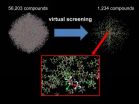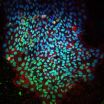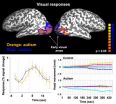CHICAGO, IL, September 20, 2012 (Press-News.org) Lopid and Tricor, FDA-approved lipid-lowering medications, may prevent the progression of late infantile Batten disease. Batten diseases are a group of devastating neurodegenerative disorders that begin in childhood. In case of the late infantile Batten disease, death usually occurs between the ages of 8 and 14 depending on the rate of disease progression. Currently, no drug is available to halt the disease progression.
Neurological researchers at the Rush University Medical Center (Chicago) have found that gemfibrozil and fenofibrate, known as Lopid and Tricor, respectively in US Pharmacies, successfully increase the amount and function of a protein that is either low or missing in late infantile Batten disease. Results of the study were published in the Journal of Biological Chemistry, September 18, 2012.
"Understanding mechanism of the disease is important to developing effective drugs that protect the brain and stop the progression of Batten," said Kalipada Pahan, the communicating author of the study. He is a professor of Neurological Sciences, Biochemistry and Pharmacology and the Floyd Davis Endowed Chair of Neurology at the Rush University Medical Center. Other researchers at the Rush University involved in this study were Arunava Ghosh and Grant T. Corbett.
Although due to gene mutation, one protein called tripeptidyl tripeptidase I (TPP-I) is absent in late infantile Batten disease, a few copies of normal gene remain in affected patients. "Therefore, one approach for treatment could be to enhance the levels of normal TPP-I protein", said Dr. Pahan.
The authors have shown that in addition to Lopid and Tricor, retinoic acid (vitamin A) also increases the TPP-I protein in brain cells. "Therefore, vitamin A supplementation could be beneficial for patients with late infantile Batten disease," Dr. Pahan said.
Sometimes a combination of low-dose medications works better than larger doses of one single drug. "Interestingly, the combination of vitamin A and Lopid at very low doses greatly stimulates this protein," Dr. Pahan said.
This research was supported by a generous donation from Noah's Hope Foundation and a grant from National Institutes of Health to Dr. Pahan. "Now we need to translate this finding to the clinic and test if the combination of vitamin A and Lopid or Tricor delays disease progression and prolongs life span in affected children. If these results are replicated in patients, it would open up a promising avenue of treatment of this devastating disease," Dr. Pahan said.
Batten disease is rare and occurs in an estimated 2 to 4 out of every 100,000 births in the United States. It is inherited in an autosomal recessive pattern. The mutation causes the buildup of pigments called lipofuscins in the brain, leading to neuronal death. Eventually, children with Batten disease become blind, bedridden, and demented. Batten Disease is a life limiting disease; life expectancy varies depending on the type or variation. Death usually occurs in middle childhood between the ages of 5 and 14 years, depending on the speed of disease progression.
Website: http://www.pahanlab.com
Scientists Identify Drugs for Batten Disease
Currently, no effective drug is available for Batten diseases, a group of devastating disorders in children. FDA-approved lipid-lowering drugs Lopid and Tricor, in combination with vitamin A, may help patients with late infantile Batten disease.
2012-09-20
ELSE PRESS RELEASES FROM THIS DATE:
Trafalgar Launches 2013 First Class Europe & Britain Brochure With 104 Itineraries & Massive Savings
2012-09-20
Trafalgar (www.trafalgar.com), the Insider of guided vacations, is excited to announce the release of their 2013 Europe & Britain First Class brochure, packed with an impressive 104 itineraries across 37 countries, 3 of which are Inspired Vacations that cater to specific traveler interests. Each itinerary includes exclusive sightseeing at Europe's most famous landmarks, as well as a wealth of exclusive Insider Experiences, from immersing themselves in a region's Local Specialties to the Unique Insights they'll receive from Trafalgar's Local Guides. The new brochure ...
Jose Canseco Discusses Fall from Fame and Success
2012-09-20
Jose Canseco gives an insider point of view of what it's like to experience a public fall from grace.
In his latest, exciting video blog for Steroid.com, Jose Canseco candidly discusses the twisted spiral of what it was like to experience a much publicized fall from fame and success. Covering topics ranging from losing millions, no longer being in the game, and personal struggles, Canseco offers an insightful glimpse into the highs and lows of a professional sports career. Regarding becoming addicted to the success and fame, he says...
"You know I do think you ...
New NIST screening method identifies 1,200 candidate refrigerants to combat global warming
2012-09-19
Researchers at the National Institute of Standards and Technology (NIST) have developed a new computational method for identifying candidate refrigerant fluids with low "global warming potential" (GWP) — the tendency to trap heat in the atmosphere for many decades — as well as other desirable performance and safety features.
The NIST effort is the most extensive systematic search for a new class of refrigerants that meet the latest concerns about climate change. The new method was used to identify about 1,200 promising, low-GWP chemicals* for further study among some ...
Discovery of reprogramming signature may help further stem cell-based regenerative medicine research
2012-09-19
LA JOLLA, CA---- Salk scientists have identified a unique molecular signature in induced pluripotent stem cells (iPSCs), "reprogrammed" cells that show great promise in regenerative medicine thanks to their ability to generate a range of body tissues.
In this week's Proceedings of the National Academy of Sciences, the Salk scientists and their collaborators at University of California, San Diego, report that there is a consistent, signature difference between embryonic and induced pluripotent stem cells. The findings could help overcome hurdles to using the induced stem ...
Sandia shows monitoring brain activity during study can help predict test performance
2012-09-19
ALBUQUERQUE, N.M. — Research at Sandia National Laboratories has shown that it's possible to predict how well people will remember information by monitoring their brain activity while they study.
A team under Laura Matzen of Sandia's cognitive systems group was the first to demonstrate predictions based on the results of monitoring test volunteers with electroencephalography (EEG) sensors.
For example, "if you had someone learning new material and you were recording the EEG, you might be able to tell them, 'You're going to forget this, you should study this again,' ...
Major changes needed to protect Australia's species and ecosystems
2012-09-19
A study has highlighted the sensitivity of Australia's species and ecosystems to climate change, and the need for new ways of thinking about biodiversity conservation.
'Climate change is likely to start to transform some of Australia's natural landscapes by 2030,' lead researcher, CSIRO's Dr Michael Dunlop said.
'By 2070, the ecological impacts are likely to be very significant and widespread. Many of the environments our plants and animals currently exist in will disappear from the continent. Our grandchildren are likely to experience landscapes that are very different ...
NYU neuroscientists find promise in addressing Fragile X afflictions
2012-09-19
Neuroscientists at New York University have devised a method that has reduced several afflictions associated with Fragile X syndrome (FXS) in laboratory mice. Their findings, which are reported in the journal Neuron, offer new possibilities for addressing FXS, the leading inherited cause of autism and intellectual disability.
Those afflicted with FXS do not possess the protein FMRP, which is a suppressor of protein synthesis. Absent this suppressor, protein synthesis is exaggerated, producing a range of mental and physical disorders.
Previous research has indirectly ...
Scientists show biological mechanism can trigger epileptic seizures
2012-09-19
CINCINNATI – Scientists have discovered the first direct evidence that a biological mechanism long suspected in epilepsy is capable of triggering the brain seizures – opening the door for studies to seek improved treatments or even preventative therapies.
Researchers at Cincinnati Children's Hospital Medical Center report Sept. 19 in Neuron that molecular disruptions in small neurons called granule cells – located in the dentate gyrus region of the brain – caused brain seizures in mice similar to those seen in human temporal lobe epilepsy.
The dentate gyrus is in the ...
Autism symptoms could arise from unreliable neural responses
2012-09-19
Diverse symptoms associated with autism could be explained by unreliable activity of neurons in the brain in response to basic, nonsocial sensory information, according to a study published by Cell Press on September 19th in the journal Neuron. The new findings suggest that autism is a disorder of general neural processing and could potentially provide an explanation for the origins of a range of psychiatric and neurological disorders.
"Within the autism research community, most researchers are looking for either a dysfunctional brain region or inadequate connections ...
Autistic adults have unreliable neural responses, Carnegie Mellon-led research team finds
2012-09-19
VIDEO:
New research led by Carnegie Mellon University neuroscientists takes the first step towards deciphering the connection between general brain function and the emergent behavioral patterns in autism. Published in...
Click here for more information.
PITTSBURGH— Autism is a disorder well known for its complex changes in behavior — including repeating actions over and over and having difficulty with social interactions and language. Current approaches to understanding ...
LAST 30 PRESS RELEASES:
University of Oklahoma researcher awarded funding to pursue AI-powered material design
Exploring how the visual system recovers following injury
Support for parents with infants at pediatric check-ups leads to better reading and math skills in elementary school
Kids’ behavioral health is a growing share of family health costs
Day & night: Cancer disrupts the brain’s natural rhythm
COVID-19 vaccination significantly reduces risk to pregnant women and baby
The role of vaccination in maternal and perinatal outcomes associated with COVID-19 in pregnancy
Mayo Clinic smartwatch system helps parents shorten and defuse children's severe tantrums early
Behavioral health spending spikes to 40% of all children’s health expenditures, nearly doubling in a decade
Digital cognitive behavioral treatment for generalized anxiety disorder
Expenditures for pediatric behavioral health care over time and estimated family financial burden
Air conditioning in nursing homes and mortality during extreme heat
The Alps to lose a record number of glaciers in the next decade
What makes a good proton conductor?
New science reporting guide published for journalists in Bulgaria
New international study reveals major survival gaps among children with cancer
New science reporting guide published for journalists in Turkey
Scientists develop a smarter mRNA therapy that knows which cells to target
Neuroanatomy-informed brain–machine hybrid intelligence for robust acoustic target detection
Eight SwRI hydrogen projects funded by ENERGYWERX
The Lundquist Institute and its start-up company Vitalex Biosciences Announces Strategic Advancement of Second-Generation fungal Vaccine VXV-01 through Phase 1 Trials under $40 Million Competitive Con
Fine particles in pollution are associated with early signs of autoimmune disease
Review article | Towards a Global Ground-Based Earth Observatory (GGBEO): Leveraging existing systems and networks
Penn and UMich create world’s smallest programmable, autonomous robots
Cleveland researchers launch first major study to address ‘hidden performance killer’ in athletes
To connect across politics, try saying what you oppose
Modulating key interaction prevents virus from entering cells
Project explores barriers to NHS career progression facing international medical graduates
Jeonbuk National University researchers explore the impact of different seasonings on the flavor perception of Doenjang soup
Two Keck Medicine of USC Hospitals named Leapfrog Top Teaching Hospitals
[Press-News.org] Scientists Identify Drugs for Batten DiseaseCurrently, no effective drug is available for Batten diseases, a group of devastating disorders in children. FDA-approved lipid-lowering drugs Lopid and Tricor, in combination with vitamin A, may help patients with late infantile Batten disease.




